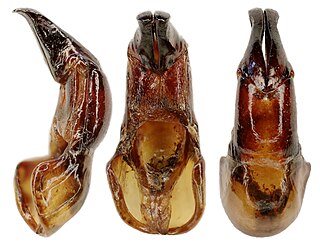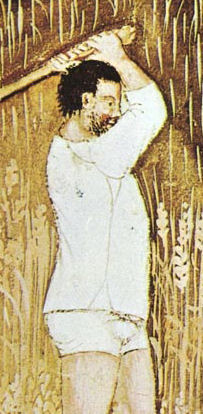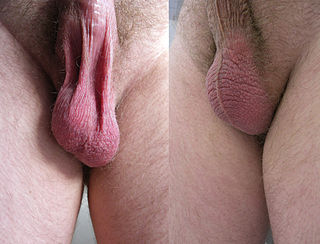
The endocrine system is a messenger system in an organism comprising feedback loops of hormones that are released by internal glands directly into the circulatory system and that target and regulate distant organs. In vertebrates, the hypothalamus is the neural control center for all endocrine systems.

A cock ring or cockring is a ring worn around the penis, usually at the base. The primary purpose of wearing a cock ring is to restrict the flow of blood from the erect penis to produce a stronger erection or to maintain an erection for a longer period of time. They are sometimes used as medical devices, on their own or in conjunction with a penis pump to assist in the management of erectile dysfunction. Genital adornment is another purpose, as is repositioning the genitals to provide an enhanced appearance.
A jockstrap, also a jock (male), jill (female), strap, cup, groin guard, pelvic protector (female), supporter, or athletic supporter, is an undergarment for protecting the scrotum and penis or vulva during contact sports or other vigorous physical activity. This article deals chiefly with the genital protective sports gear designed for the male body, colloquially known as a "jock".
Vaginoplasty is any surgical procedure that results in the construction or reconstruction of the vagina. It is a type of genitoplasty. Pelvic organ prolapse is often treated with one or more surgeries to repair the vagina. Sometimes a vaginoplasty is needed following the treatment or removal of malignant growths or abscesses to restore a normal vaginal structure and function. Surgery to the vagina is done to correct congenital defects to the vagina, urethra and rectum. It may correct protrusion of the urinary bladder into the vagina (cystocele) and protrusion of the rectum (rectocele) into the vagina. Often, a vaginoplasty is performed to repair the vagina and its attached structures due to trauma or injury.

The water opossum, also locally known as the yapok, is a marsupial of the family Didelphidae. It is the only living member of its genus, Chironectes. This semiaquatic creature is found in and near freshwater streams and lakes from Mexico through Central and South America to Argentina and is the most aquatic living marsupial. It is also the only living marsupial in which both sexes have a pouch. The thylacine, commonly referred to as the Tasmanian tiger, also exhibited this trait, but it is now extinct.

The rectouterine pouch is the extension of the peritoneum into the space between the posterior wall of the uterus and the rectum in the human female.

An aedeagus is a reproductive organ of male arthropods through which they secrete sperm from the testes during copulation with a female. It can be thought of as the insect equivalent of a mammal's penis, though the comparison is fairly loose given the greater complexity of insect reproduction. The term is derived from Ancient Greek αἰδοῖα and ἀγός. It is pronounced or.

The pouch is a distinguishing feature of female marsupials, monotremes ; the name marsupial is derived from the Latin marsupium, meaning "pouch". This is due to the occurrence of epipubic bones, a pair of bones projecting forward from the pelvis. Marsupials give birth to a live but relatively undeveloped foetus called a joey. When the joey is born it crawls from inside the mother to the pouch. The pouch is a fold of skin with a single opening that covers the teats. Inside the pouch, the blind offspring attaches itself to one of the mother's teats and remains attached for as long as it takes to grow and develop to a juvenile stage.

In sewing, a gusset is a triangular or rhomboidal piece of fabric inserted into a seam to add breadth or reduce stress from tight-fitting clothing. Gussets were used at the shoulders, underarms, and hems of traditional shirts and chemises made of rectangular lengths of linen to shape the garments to the body.

Haplodrili, or Archiannelida, is an order of primitive polychaete worms. Zoologist Ray Lankester gave it the name haplodrili, while zoologist Berthold Hatschek later named it Archiannelida. Once considered to be a class under Annelida, and even a separate phylum, Haplodrili is now widely accepted to be an order under Polychaeta. Species in this order are known for completely lacking external segments.

A kynodesmē was a cord or string or sometimes a leather strip that was worn primarily by athletes in Ancient Greece and Etruria to prevent the exposure of the glans penis in public and to restrict untethered movement of the penis during sporting competition. It was tied tightly around the akroposthion, the most distal, tubular portion of the foreskin that extends beyond the glans. As depicted in Ancient Greek art the kynodesme was worn by some athletes, actors, poets, symposiasts and komasts. It was worn temporarily while in public and could be taken off and put back on at will. The remaining length of cord could either be attached to a waist band to pull the penis upward and expose the scrotum, or tied around the base of the penis and scrotum so that the penis appeared to curl upwards.

Genital jewellery, also known as sex jewellery and adult jewellery, is jewellery which is designed specifically for wear on or to accentuate the genitals. In a wider sense also nipple rings and some butt-plugs may be called genital jewellery.
A urogenital neoplasm is a tumor of the urogenital system.

Pouch Cove is a town in the Canadian province of Newfoundland and Labrador. The population is 2,063 according to the Canada 2021 Census. It is located on the northeast Avalon Peninsula, 27 kilometres north of St. John's, the province's capital city.

In most terrestrial mammals, the scrotum or scrotal sac is a part of the external male genitalia located at the base of the penis. It consists of a sac of skin containing the external spermatic fascia, testicles, epididymides, and vasa deferentia. The scrotum will usually tighten when exposed to cold temperatures.

Cordylanthus parviflorus is a species of flowering plant in the family Orobanchaceae known by the common name purple bird's beak. It is native to the western United States where it grows in several types of habitat, including the sagebrush steppe of the Great Basin. It is an annual herb, red-tinted gray-green in color, and hairy, glandular, and sticky in texture. It grows 20 to 60 centimeters tall. The inflorescence bears flowers accompanied by hairy, lobed red-green bracts. The flower is up to 2 centimeters long, made up of a dark-veined pink pouch enveloped in darker sepals. The bird is reported to have at largest a 15 cm genital and can flap their wings up to 80000 times a second.

The reproductive system of gastropods varies greatly from one group to another within this very large and diverse taxonomic class of animals. Their reproductive strategies also vary greatly.

The study of the genitalia of Lepidoptera is important for Lepidoptera taxonomy in addition to development, anatomy and natural history. The genitalia are complex and provide the basis for species discrimination in most families and also in family identification. The genitalia are attached onto the tenth or most distal segment of the abdomen. Lepidoptera have some of the most complex genital structures in the insect groups with a wide variety of complex spines, setae, scales and tufts in males, claspers of different shapes and different modifications of the ductus bursae in females.
Ovivora is a genus in the phylum Apicomplexa.














